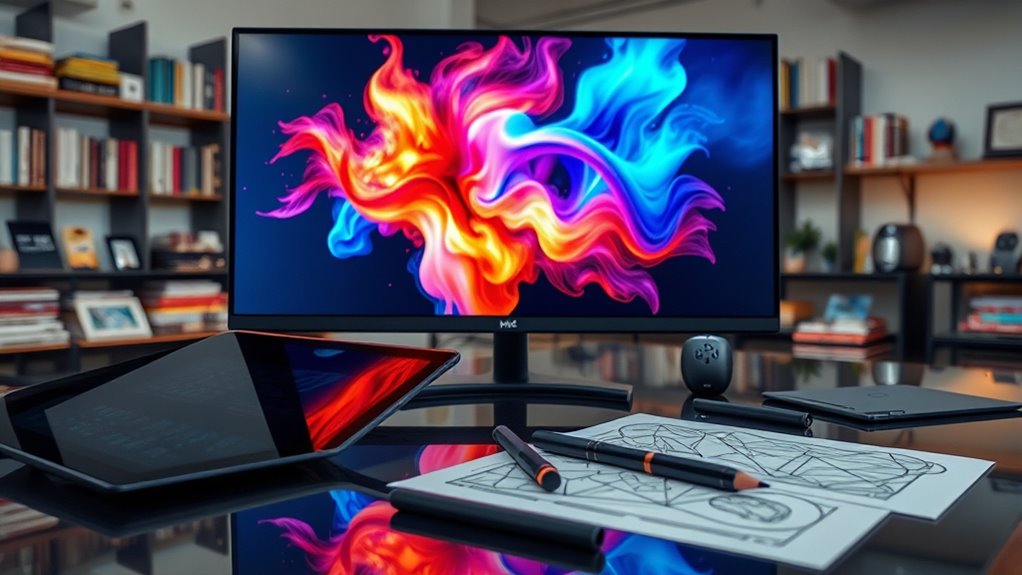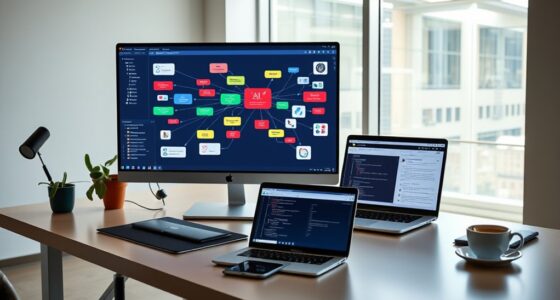To create and sell AI art and design assets, start by understanding licensing terms to guarantee legal use and profit from your work. Choose the right platforms like Etsy or specialized AI sites, optimize your listings with relevant keywords, and set competitive prices. Build your brand through social media, showcase behind-the-scenes content, and engage with communities. Focusing on quality and originality can boost sales—exploring more strategies will help you succeed even further.
Key Takeaways
- Understand and secure proper licensing rights for AI-generated assets to ensure legal compliance and revenue control.
- Choose suitable marketplaces like Etsy or Creative Market, optimizing listings with relevant keywords for visibility.
- Build a strong brand presence by sharing behind-the-scenes content, tutorials, and engaging with online AI art communities.
- Continuously monitor sales performance, gather buyer feedback, and refine your offerings for better market fit.
- Diversify across multiple platforms, stay updated on trends, and focus on originality to sustain long-term growth.

Have you ever wondered how to turn your creativity into a profitable venture using AI tools? If so, diving into the world of AI-generated art and design assets might be your next big move. The key to success lies in understanding how to navigate AI generated licensing and employing effective marketplace strategies. When you create digital assets with AI, you need to think about licensing from the start. AI generated licensing can be complex, but it’s vital to clarify the rights associated with your work. Some AI tools have specific licensing agreements that dictate how you can sell or distribute your assets. Ensuring you understand these terms helps you avoid legal pitfalls and maximizes your earning potential. You might also consider licensing your AI-generated art through platforms that offer royalty arrangements or licensing options. This way, you retain control over your creations while earning passive income whenever someone uses or licenses your work.
Understanding AI licensing is crucial for legally selling and sharing your digital art assets.
Next, you’ll want to develop smart marketplace strategies to reach your ideal audience. Choosing the right platform is essential. Art marketplaces like Etsy, Creative Market, or specialized AI art platforms provide a great starting point. Each has its own audience, fee structure, and rules, so spend time researching which aligns best with your goals. When listing your assets, optimize your product descriptions using relevant keywords that buyers search for, such as “AI art,” “digital design assets,” or “AI generated illustrations.” This boosts your visibility and attracts targeted buyers. Setting competitive prices based on the complexity and uniqueness of your work is equally important. Don’t be afraid to experiment with different pricing models or bundle deals to increase sales volume.
Building a consistent brand presence on social media can also amplify your reach. Sharing behind-the-scenes processes, time-lapse videos, or tutorials about how you create with AI can engage potential buyers and establish your reputation as a reliable creator. Collaborating with other artists or participating in online communities focused on AI art can open up new opportunities and help you stay ahead of trends. Remember, the effectiveness of your marketplace strategies hinges on understanding your audience’s preferences and continuously adapting your approach. Keep track of what sells best, gather feedback, and refine your listings accordingly. Additionally, exploring Unique and Wicked Planters or other innovative product ideas can inspire new avenues for your digital assets.
Turning your AI-generated art into a profitable venture requires a blend of strategic licensing practices and savvy marketplace tactics. By mastering AI generated licensing and positioning your assets thoughtfully, you set yourself up for sustainable success. Stay flexible, keep exploring new platforms, and always prioritize quality and originality. With persistence and a clear plan, you’ll transform your creative ideas into a thriving digital business.
Frequently Asked Questions
How Do I Protect My Ai-Generated Artwork From Theft?
To safeguard your AI-generated artwork from theft, you should establish clear licensing agreements and register your work for copyright protection. Always include licensing terms when sharing or selling your art, specifying how others can use it. Keep detailed records of your creation process and timestamps. Using watermarks can deter unauthorized use. These steps help address copyright concerns and ensure you maintain control over your AI art.
What Legal Rights Do I Have Over Ai-Created Designs?
You have some legal rights over your AI-created designs, especially regarding intellectual property and copyright ownership. While the legal landscape is still evolving, generally, if you contributed markedly to the creation process, you can claim copyright ownership. It’s important to document your work and understand applicable laws in your jurisdiction, as rights may vary. Consulting a legal professional can help clarify your specific rights and protect your designs effectively.
Can I Sell AI Art on Multiple Platforms Simultaneously?
Yes, you can sell AI art on multiple platforms simultaneously, like planting your seeds in various gardens. Just keep an eye on platform royalties and licensing agreements—some sites may have restrictions or specific rules. You’re the captain of your ship, so review each platform’s policies carefully to avoid storms. Managing your sales across platforms boosts your reach, but stay informed to keep your creative voyage smooth and profitable.
How Do I Price AI Art Assets Competitively?
To price your AI art assets competitively, start with solid market research to understand what similar assets sell for. Use pricing strategies like tiered pricing or bundle deals to attract buyers. Keep an eye on platform trends and adjust your prices accordingly. Remember, competitive pricing balances affordability with value, so don’t undervalue your work. Regularly review the market to stay ahead and maximize your sales potential.
What Are the Best Tools for Customizing Ai-Generated Designs?
You should explore top AI customization tools like Adobe Photoshop, Canva, and Figma, which offer powerful features for tweaking AI-generated designs. These design tools allow you to fine-tune details, adjust colors, and add personal touches with ease. By combining AI customization with these versatile design tools, you can create unique, high-quality assets that stand out in the market and meet your clients’ specific needs effectively.
Conclusion
Now, imagine your AI-generated art shimmering on screens worldwide, each piece catching eyes like stars in a night sky. With every click and sale, you’re building a vibrant gallery of your creativity, fueling your passion and income. Keep honing your skills, explore new tools, and let your imagination run wild. Your unique assets can color the digital world—turn your ideas into a thriving marketplace and watch your artistic universe expand before your eyes.









